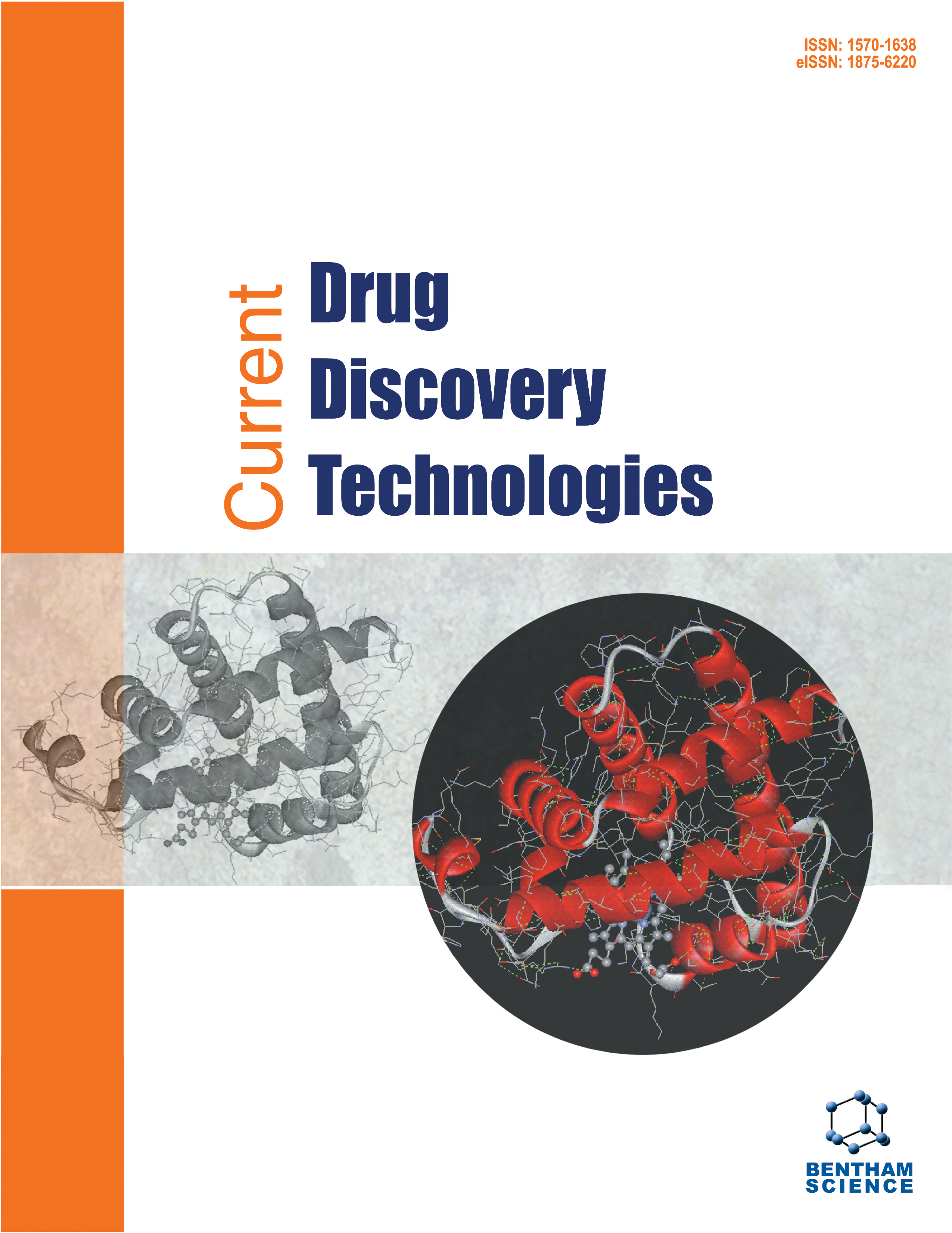- Home
- A-Z Publications
- Current Drug Discovery Technologies
- Previous Issues
- Volume 8, Issue 4, 2011
Current Drug Discovery Technologies - Volume 8, Issue 4, 2011
Volume 8, Issue 4, 2011
-
-
Editorial [Hot Topic: Physico-chemical Approach to Targeting Phenomena (Guest Editors: Sadao Hirota and Nejat Duzgunes)]
More LessAuthors: Sadao Hirota and Nejat DuzgunesDrug targeting is one of the most important phenomena for therapies of diseases. The phenomena have been divided into two categories, passive targeting in which drug carriers circulate in the bloodstream and accumulate in a target tissue without any specific interactions, and active targeting in which drug carriers with ligands accumulate in a target tissue with receptors through ligand-receptor interactions. The enha Read More
-
-
-
Kinetic and Thermodynamic Approaches to the Drug Targeting Phenomena
More LessAuthors: Igor Meerovich, Alexander Koshkaryev and Vladimir P. TorchilinThe effectiveness of many promising drug candidates (e.g. anticancer agents) awaits the development of drug forms capable of delivery of their drug load specifically to particular sites of an organism or a cell. To make universal and efficient drug carriers, administered drug-loaded vehicles should be able to reach the pathologic zone, recognize and bind their targets at a therapeutic concentration before clearance from the Read More
-
-
-
Inhomogeneous Molecular Distribution in Self-Spreading Lipid Bilayers at the Solid/Liquid Interface
More LessAuthors: Hideki Nabika, Tomoki Sumida and Kei MurakoshiSelf-spreading lipid bilayers at the solid/liquid interface can be used as a molecular transport medium in targeting nano-devices such as drug delivery and micro-total analytical systems. To gain physico-chemical insight in the selfspreading lipid bilayer, we have characterized the distribution of dye-labeled lipids in the upper and lower monolayers of a self-spreading lipid bilayer on a hydrophobic substrate by fluorescence que Read More
-
-
-
Artificial Chaperone Polysaccharide Nanogels for Protein Delivery: A Thermodynamic Study of Protein-Nanogel Interactions Using Fluorescence Correlation Spectroscopy
More LessAuthors: Yoshihiro Sasaki, Daisuke Iida, Haruko Takahashi, Shin-ichi Sawada and Kazunari AkiyoshiMolecular chaperones selectively trap heat-denatured proteins or their intermediates, primarily by hydrophobic interactions, to prevent irreversible aggregation resulting from macromolecular host (molecular chaperone)-guest (protein) interactions. The molecular chaperone function is an important concept that is expected to lead to breakthroughs in drug delivery systems, especially for protein or peptide delivery in regen Read More
-
-
-
Supporting the Design of Efficient Dendritic DNA and siRNA Nano-Carriers with Molecular Modeling
More LessAuthors: Giovanni M. Pavan and Andrea DananiThe design of macromolecules able to generate a stable binding with nucleic acids is of great interest for their possible application in gene delivery. During the last years particular attention has been addressed to the use of dendritic scaffolds as a base to construct efficient DNA and siRNA nano-carriers. Dendrimers and dendrons are hyperbranched polymers characterized by a well-defined structure and by the possibility to funct Read More
-
-
-
Physicochemical Properties of pDNA/Chitosan Complexes as Gene Delivery Systems
More LessAuthors: Kenji Hagiwara, Riany Anastasia, Mitsuhiro Nakata and Toshinori SatoSuccessful gene therapy depends on the development of effective gene carriers. Naturally occurring chitosan has been employed widely as a non-viral gene carrier because of its low toxicity, low immunogenicity, biocompatibility, and biodegradability. In this review, we summarize the utilization of chitosan, modified chitosan, and chitosan-containing ternary complexes as gene carriers. In particular, we discuss the influence of th Read More
-
-
-
Rheological Approach to Targeting Phenomena of Lipoplexes
More LessBy Yan SunLipoplexes, the complexes of plasmid DNA with cationic lipids, are considered as an attractive alternative to viral delivery systems. However, synthesized lipoplexes showed several limitations including insufficient transfection, low reproducibility and low stability. Here we attempt to delineate the relationships between the synthesis process, morphology (e.g., shape and liquid crystal structure), and the transfection effi Read More
-
-
-
Correlation of Fixed Aqueous Layer Thickness Around PEG-modified Liposomes with In Vivo Efficacy of Antitumor Agent-containing Liposomes
More LessAuthors: Ikumi Sugiyama and Yasuyuki SadzukaLiposomes are recognized as useful drug carriers, but have some problems to overcome. Liposomes are easily opsonized with serum proteins (opsonization) and taken up by the reticuloendothelial system (RES) cells, such as spleen and liver. Polyethyleneglycol (PEG) modification on the liposomal membrane forms a fixed aqueous layer and thus prevents opsonization and uptake by the RES. Our research indicates clearly Read More
-
-
-
Lectin-Immobilized Fluorescent Nanospheres for Targeting to Colorectal Cancer from a Physicochemical Perspective
More LessAuthors: Shinji Sakuma, Shinji Yamashita, Ken-ichiro Hiwatari, Robert M. Hoffman and Wellington PhamThe goal of this research is to develop an imaging agent that enables real-time and accurate diagnosis of smallsized colorectal cancer. Since colorectal cancer initially develops in the mucous membrane of the large intestine, a nonabsorbable colonoscopic imaging agent capable of being administered intracolonically was designed. The imaging agent is peanut agglutinin (PNA)-immobilized polystyrene nanospheres with sur Read More
-
Volumes & issues
-
Volume 22 (2025)
-
Volume 21 (2024)
-
Volume 20 (2023)
-
Volume 19 (2022)
-
Volume 18 (2021)
-
Volume 17 (2020)
-
Volume 16 (2019)
-
Volume 15 (2018)
-
Volume 14 (2017)
-
Volume 13 (2016)
-
Volume 12 (2015)
-
Volume 11 (2014)
-
Volume 10 (2013)
-
Volume 9 (2012)
-
Volume 8 (2011)
-
Volume 7 (2010)
-
Volume 6 (2009)
-
Volume 5 (2008)
-
Volume 4 (2007)
-
Volume 3 (2006)
-
Volume 2 (2005)
-
Volume 1 (2004)
Most Read This Month
Article
content/journals/cddt
Journal
10
5
false
en


